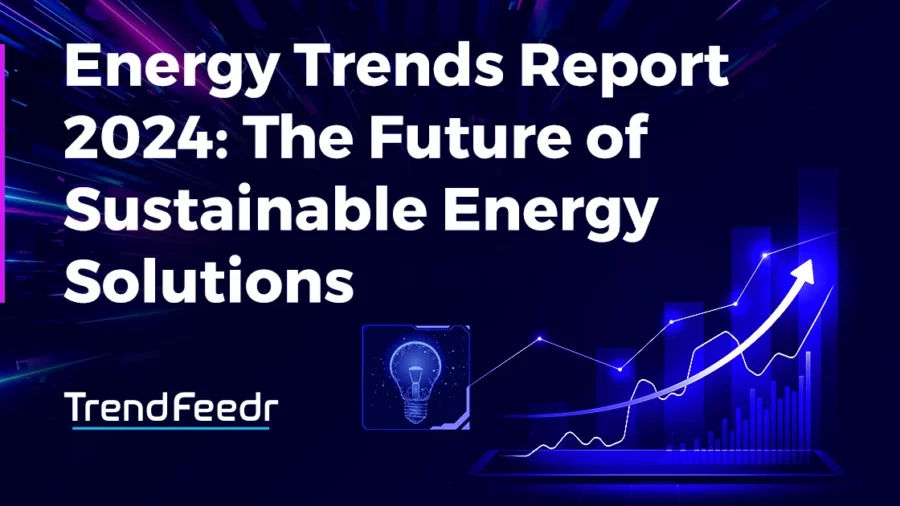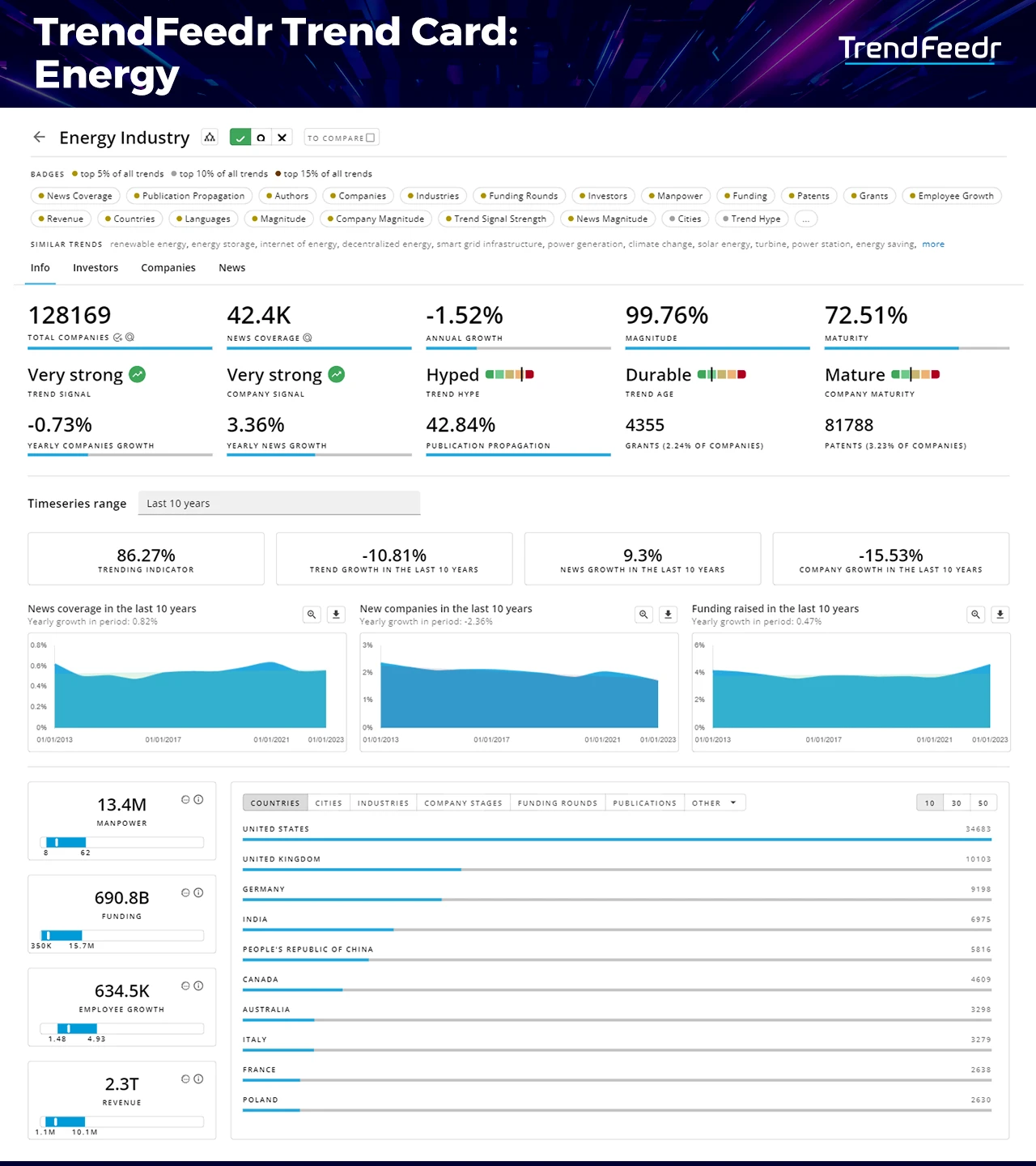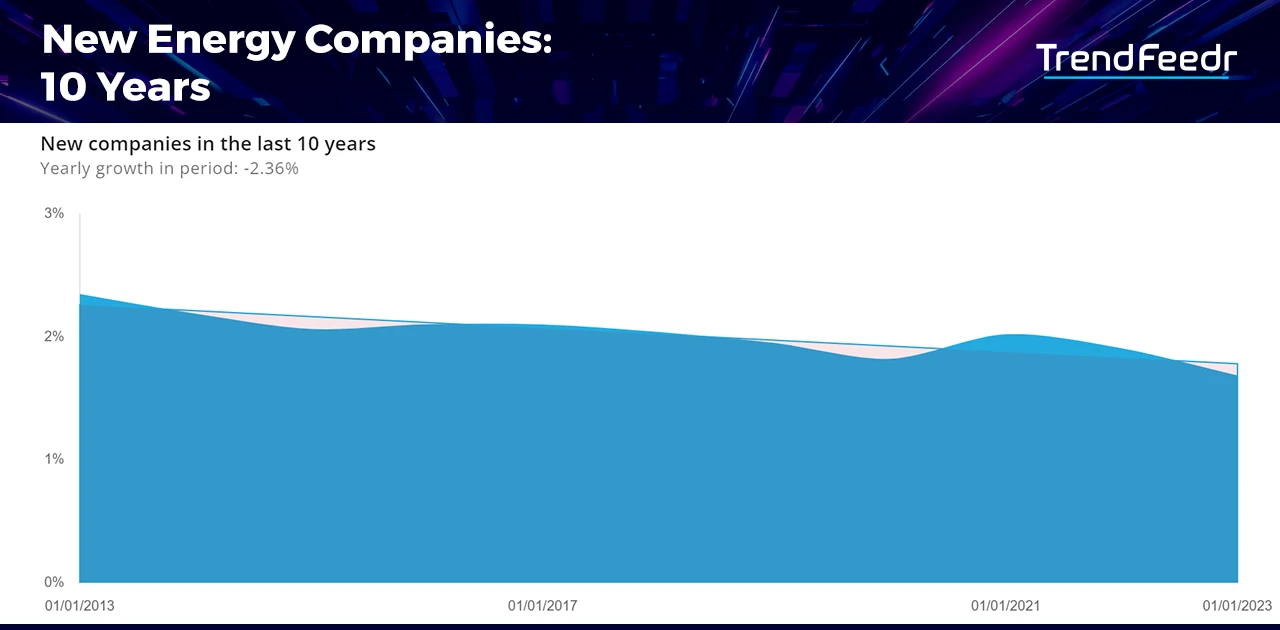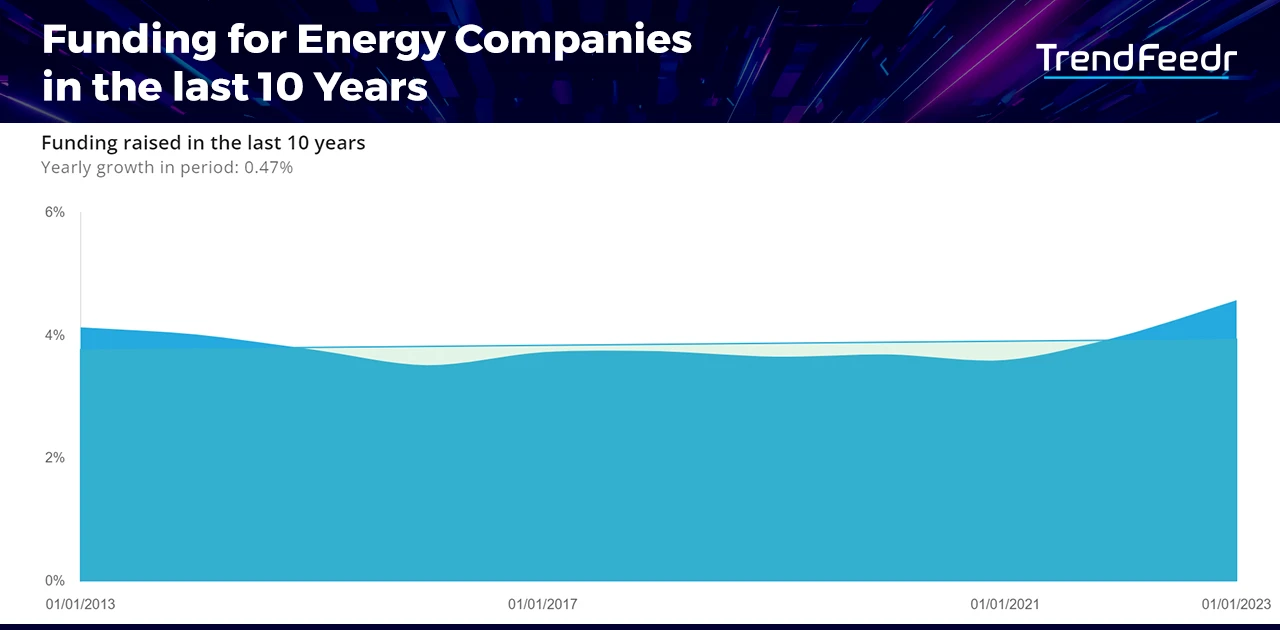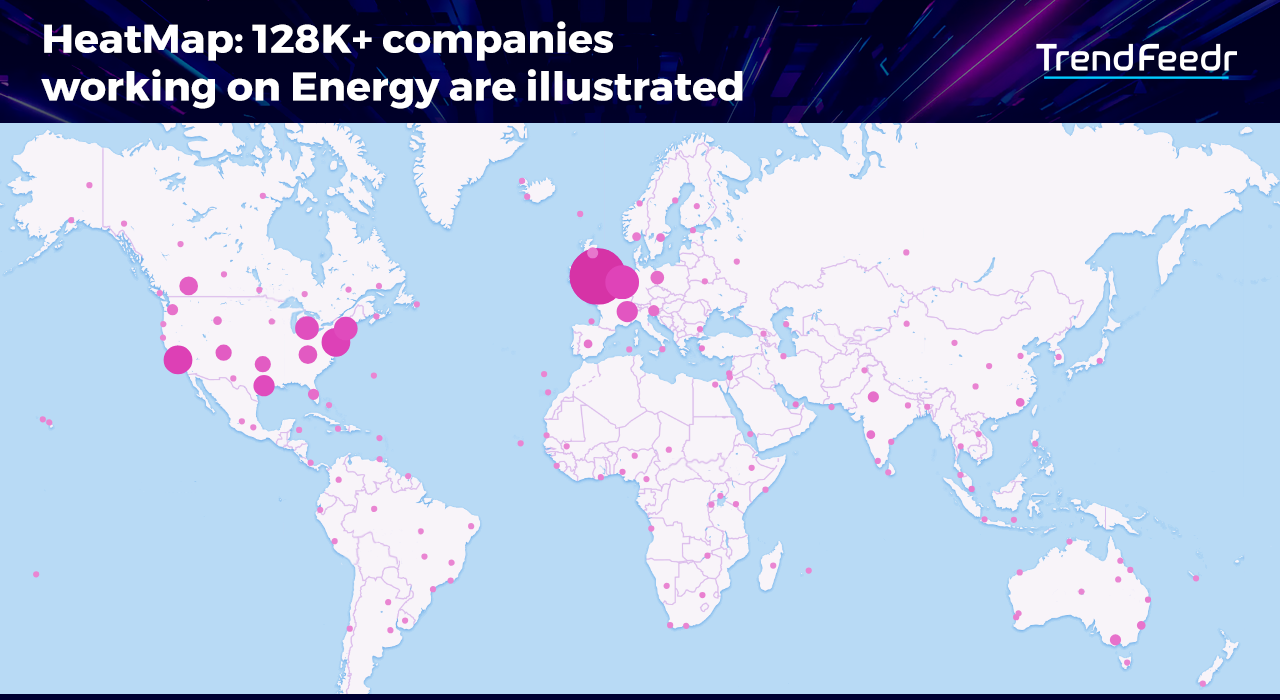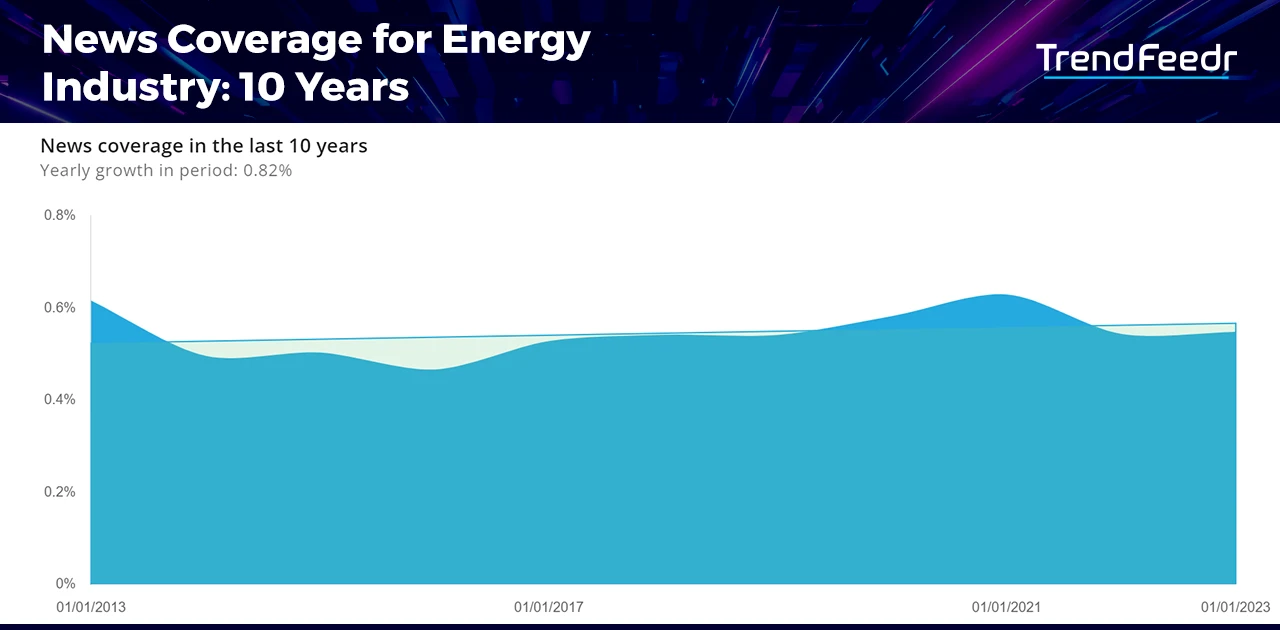We are transitioning into a new energy era marked by a remarkable convergence of technology and resource management. That’s why this energy trends report explains the role of recent innovations in shaping a sustainable future.
The advent of smart grids, the widespread adoption of renewable energy sources, and the transformative influence of AI on energy management are significant. Among others, these developments are addressing urgent challenges such as the need to reduce carbon emissions, optimize energy use, and integrate diverse energy systems. From expansive solar farms to towering offshore wind turbines, each new technology is a testament to innovation.
Current market trends prove the growing impact of these emerging technologies: the global renewable energy market was valued at US$881.7 billion in 2020 and is projected to grow at a CAGR of 8.4% from 2021 to 2028, according to Allied Market Research.
This indicates strong growth and also highlights the increasing significance of innovative energy solutions. New energy solutions are propelling not just the industry itself, but the global economy as well. Interestingly, the World Economic Forum reports that the shift to clean energy could generate 10.3 million net new jobs worldwide by 2030.
In this data-driven energy trends report, we delve into the current trends in energy, emphasizing renewable energy, energy storage, internet of energy, decentralized energy, and smart grid infrastructure.
Key Takeaways
- Important Trend: With a trend magnitude of 99.76% and a trend maturity of 72.51%, according to TrendFeedr, the energy sector is central to global sustainable development and innovation efforts.
- Technological Convergence: Energy firms are increasingly integrating key trends such as renewable energy, energy storage, the internet of energy, decentralized energy, and smart grid infrastructure.
- Media Coverage: The steady annual growth of 0.82% in news coverage over the past decade underscores the growing relevance of the energy sector and public interest in sustainable, innovative energy solutions.
- Organizational & Investment Landscape: The energy sector, with about 128,000 active entities and investment capital of around US$700 billion, showcases dynamic growth and potential for ongoing innovation.
- Prominent Investors like GIC, International Finance Corporation, and Warburg Pincus are investing billions in innovative energy ventures, driving new technologies and solutions.
- Global Implementation: The United States, United Kingdom, Germany, India, and China lead in energy initiatives. London, Houston, New York City, Melbourne, and Sydney are key cities in energy advancements.
Table of Contents
- Understanding Energy Trends
- Energy Industry Trend Card
- Emerging Trends & Technologies Disrupting Energy
- 5 Key Energy Trends
- 5 Emerging Energy Companies
- Energy Investment Trends
- Mapping Global Energy Companies
- Media Coverage of Energy
- Future of Energy
For this detailed analysis of energy trends, we use TrendFeedr, our all-in-one trend intelligence platform. TrendFeedr uses advanced algorithms to identify future industry and tech trends. With a focus on trend discovery, clustering, and analysis, the AI-powered platform reviews thousands of trends each week to provide actionable insights.
Among more than 20,000 trends and technologies monitored by TrendFeedr, the energy sector has made a substantial imprint. Here’s why:
- Energy ranks among the top 50 trends and falls within the top 1% of global trends, underscoring its pivotal role in shaping economic and environmental futures.
- With a trend maturity of 72.51%, energy stands out as a trend indicating a solid development stage with high potential for further innovation and market growth.
- The emphasis on sustainable and renewable energy sources is transforming the sector, spurring investments and policy changes globally, and paving the way for a more sustainable future.
This energy trends report explores various aspects including performance, investment, regional, and future outlook.
Understanding Energy Industry Trends
The energy sector, a complex and transformative landscape, is witnessing varied and influential trends. Let’s delve into some of the most significant trends that are currently shaping the energy industry.
What are the trends in the energy industry?
The decentralization of energy systems marks a monumental shift in power production and distribution. This trend is fueled by the widespread adoption of renewable energy sources. It enables the establishment of smaller, distributed energy generation sites that can function independently from the traditional grid.
Simultaneously, the electrification of transport is gaining momentum. With the rise in the popularity of electric vehicles (EVs), the energy industry is evolving. It is catering to the growing demand for electricity and is innovating solutions for large-scale EV charging infrastructure.
Advances in energy storage, particularly in battery technology, are revolutionizing renewable energy by ensuring a consistent power supply. Moreover, the emergence of demand response technologies is enhancing the flexibility and responsiveness of energy systems to fluctuations in energy demand. This further improves grid stabilization.
What are emerging technologies in the energy industry?
These trends are underpinned by emerging technologies that provide the necessary tools and innovations to realize these shifts.
AI and machine learning (ML) are enhancing the intelligence and efficiency of energy systems, from predictive maintenance of infrastructure to real-time optimization of energy consumption. The Internet of Things (IoT) is facilitating device interconnectivity and enabling smart grids. They communicate and automatically adjust based on usage patterns and energy supply.
Solar energy is experiencing a quantum leap with the introduction of advanced photovoltaic cells. It offers higher efficiency rates and integrates into various surfaces, thereby expanding the potential for solar installations. Lastly, the use of blockchain in energy transactions is enhancing the transparency, efficiency, and security of energy trading between producers and consumers.
Energy Trend Card: A Global Overview of the Dynamic Energy Landscape
The Energy Trend Card provides an insightful snapshot of the dynamic energy sector, shedding light on key metrics:
- Company Overview: The energy sector is robust, with a total of 128,169 companies. Despite a slight dip of 1.52% in annual growth, the sector continues to exhibit a strong trend.
- Maturity and Outlook: The industry boasts a high maturity level of 72.51%, characterized as ‘Durable’ in trend age, indicating its well-established position with potential for ongoing evolution.
- Media Spotlight: With 42.4K instances of news coverage and a 3.36% growth in yearly news attention, the energy industry remains a focal point of media interest, underpinning its critical role in global economies and environmental discourse.
- Innovation & Intellectual Property: A total of 81,788 patents have been filed, reflecting the industry’s commitment to innovation and technological progress. Moreover, with 4,355 grants given, accounting for 2.24% of companies, the industry showcases its durable nature and investment in research and development.
- Financial Flow & Company Growth: The sector has seen a significant inflow of funding amounting to US$690.8 billion, with a slight contraction in company growth (-15.53%) over the last decade, which may signal consolidation or market saturation.
- Employment & Economic Contribution: The energy sector employs 13.4 million people globally and has seen considerable employee growth, with a total revenue generation of US$2.3 trillion, indicating its massive contribution to the global economy.
- Global Footprint: The United States leads the charge, followed by the United Kingdom and Germany, among the countries with the most active companies in the energy space.
Keep reading as we unpack these intriguing numbers and their implications, offering a deeper understanding of the energy sector’s trajectory and its pivotal role in shaping the future.
Looking for all trends related to the energy sector?
How do Emerging Trends and Technologies Disrupt the Energy Industry?
The energy industry, a critical pillar of the global economy, is experiencing a paradigm shift due to the advent of new trends and technologies. These innovations are enhancing existing operations and altering the industry’s landscape. Let’s delve into how these trends are being actualized by trailblazing companies.
Renewable Energy
Renewable energy is spearheading the global transition towards sustainable power sources. This trend involves harnessing solar, wind, hydro, and other renewable resources to diminish reliance on fossil fuels and mitigate environmental impact.
Companies such as Mekeran Energy & Infra are at the forefront of this movement. They specialize in devising tailored solar energy solutions to tackle the issues of expensive and low-quality supplies. By constructing reliable and cost-effective solar power systems, the startup is accelerating the shift towards a more sustainable energy future.
Energy Storage
In addressing the intermittency of renewable energy sources, energy storage plays a pivotal role. It encompasses technologies that store energy for subsequent use, ensuring a steady and dependable power supply.
Envola is leading the revolution in this domain with its storage heat pumps. By incorporating an energy storage component into their heat pumps, they are achieving unparalleled efficiency and sustainability levels. This not only drives down energy and investment costs but also signifies a substantial advancement in energy storage technology.
Internet of Energy
The Internet of Energy entails the digitization of energy systems, leveraging IoT and novel connectivity technologies to increase visibility into energy consumption and distribution parameters.
Companies such as Clevernet conduct energy audits and assess the smart score of buildings, offering suggestions for enhancing efficiency through smart technology. Its services empower building owners to manage properties more effectively over the long haul, capitalizing on the latest in IoT and AI.
Decentralized Energy
Focusing on localized energy generation and distribution, distributed energy resources (DERs) empower communities and businesses to produce and manage their own energy supply.
For instance, metergrid offers a solution for profitably and automatically operating solar energy projects that provide tenants with electricity from on-site renewable energy generation. Its software handles the complex details of billing and managing electricity consumption and production, simplifying the process for decentralized energy systems.
Smart Grid Infrastructure
Smart grid infrastructure involves the integration of cutting-edge technology into the power grid, enhancing its efficiency and reliability. Additionally, it increases the grid’s capacity to support emerging energy needs like EV charging.
Yanekara, for example, amalgamates scalable hardware with cloud systems. It is developing virtual power storage systems and smart grid technology to ensure more efficient energy distribution and bolster the infrastructure for EVs.
The landscape of the energy industry is swiftly evolving, propelled by these emerging trends and technologies. These and other innovative strategies and technologies revolutionize the way we generate, store, manage, and consume energy, laying the groundwork for a more sustainable and efficient future.
5 Key Energy Trends & Firmographic Insights
The total manpower in the energy sector has reached an impressive 13.4 million individuals, with an average company size of 139 employees. This suggests the presence of large-scale operations and a multitude of medium-sized enterprises. The median of 20 employees also points to the existence of smaller, agile companies targeting niche markets or specializing in innovative technologies.
Regarding annual employee growth, the total increase of 634.5K employees across the industry paints a picture of significant momentum. The average annual employee growth rate is 8, which suggests that companies are expanding their workforce in line with strategic business developments.
Delve into the market dynamics of 5 specific trends shaping the energy sector. These trends include the rise of renewable energy, advancements in energy storage technologies, the development of smart grid infrastructure, and two additional significant movements within the sector. For each trend, we’ll explore how the number of professionals involved, the scale of investment, and the quantity and nature of organizations engaged are contributing to the evolution of these trends and the overall energy landscape.
1. Renewable Energy
- Leveraging natural resources such as wind, solar, and hydro for power generation, renewable energy stands as the cornerstone of the sustainability revolution.
- This trend has garnered the interest of an impressive 85.3K organizations and has been bolstered by a substantial funding of US$724.1 billion.
- A robust workforce of 8.1 million individuals is committed to propelling renewable energy solutions.
2. Energy Storage
- Storing power for future use, energy storage systems capture generated energy to be utilized when required.
- This trend has captivated 12.5K organizations, amassing a total investment of US$203.8 billion.
- With a dedicated team of 1.2 million, these organizations are crucial in mitigating the intermittency issues associated with renewable energy sources.
3. Internet of Energy
- The Internet of Energy trend is centered around the digital transformation and interconnection of energy assets for improved efficiency and management.
- A total of 512 organizations are pioneering this essential yet specialized area, with funding reaching US$3.3 billion.
- Their collective workforce of 72.6K is dedicated to integrating energy systems into unified, intelligent networks.
4. Decentralized Energy
- This trend focuses on localizing energy production to lessen reliance on traditional power grids.
- Decentralized energy has attracted 408 organizations, supported by US$1.2 billion in funding.
- These organizations, with a staff of 31.5K, are leading the charge in establishing self-reliant energy ecosystems.
5. Smart Grid Infrastructure
- Smart Grid Infrastructure signifies the fusion of energy and digital technology to develop more efficient and reliable power systems.
- This trend, though smaller with 71 organizations, has attracted significant backing with US$390.8 million in investments.
- With a workforce of 3K, these organizations are playing a vital role in modernizing the grid to cater to the needs of a digital world.
In essence, these trends underscore the proactive role of energy companies in shaping the future of energy, fueled by a combination of innovation, investment, and dedicated manpower.
Emerging Energy Companies Leading The Way
In the past decade, the energy sector has witnessed an annual decline of 2.36% in the emergence of new companies. This pattern suggests a phase of consolidation within the industry, characterized by the maturation or amalgamation of existing entities. Consequently, this leads to a decrease in the number of new entrants, but those that do emerge may be more resilient and competent.
5 Promising Energy Startups
Energy startups are sparking a transformation in power generation, distribution, and consumption, tackling global energy challenges with inventive solutions. From renewable energy technologies and smart grid systems to energy storage solutions and efficiency optimization, these startups are driving the transition toward a more sustainable and resilient energy landscape. Here’s a glimpse at five of the most pioneering energy startups established within the past five years and their influence on the future of the energy sector:
- Blockchain For Energy redesigns energy industry interactions on a decentralized model for the future.
- TOTEC AI Energy develops a marketplace platform that leverages intelligent routing algorithms and machine learning to optimize natural gas transportation.
- Czar Power creates an all-in-one smart energy solution to support the deployment of clean energy sources and electric fast charging.
- H2Carrier builds P2XFloater, an energy production and storage system.
- Ionic Blue crafts Energy-as-a-Service (EaaS) solutions to create a more sustainable future through decarbonization, increased energy efficiency, and greater energy savings.
Energy Industry Investment Trends
In terms of financial backing, the energy industry, with its total funding ranks in the top 5% of all 20K+ trends and technologies covered by TrendFeedr.
Over the past ten years, the energy sector has witnessed a yearly growth rate of 0.47% in funding, signaling a steady infusion of capital into the market. This growth, although incremental, suggests a consistent investor confidence in the industry’s potential.
A Closer Look at the Financials
Based on data from TrendFeedr, the energy industry has seen a staggering total funding of US$690.8 billion. The funding spectrum is broad, with the highest single investment recorded at US$3.5 billion in SPP. The average investment is US$59.1 million and the median investment is US$2.4 million. This wide range of funding signifies an active investment landscape, with both large-scale deals and smaller investments strengthening the industry.
TrendFeedr estimates the total revenue in the energy sector to be approximately US$2.3 trillion. The revenue figures also exhibit a significant variation, with the highest revenue reaching US$2.2 billion in Eneco. The average revenue is US$24 million and the median revenue is US$3.1 million.
Furthermore, a significant 9.18% of energy companies have received funding, with the types of funding spanning a wide array. Grants have been awarded to 4,355 energy companies, benefitting 2.24% of them. Early-stage VC and Series A investments have fueled the growth phases of many startups, while seed funding has provided the financial foundation for numerous innovative projects. Venture rounds have been a mainstay of continued growth, and accelerators/incubators have played a crucial role in fostering new market entrants.
Prominent Investors in the Energy Industry
GIC stands out with a total investment of US$1.6 billion across 14 companies. This includes a significant investment of US$358 million in Caltex and US$322.7 million in Climeworks.
The International Finance Corporation is another key player, with investments amounting to US$1.4 billion across 21 companies, notably US$255 million in Savannah Energy and US$138.8 million in IndiGrid.
Warburg Pincus follows closely, having allocated US$1.2 billion to 20 companies, including substantial funding of US$320 million to Viridi and US$300 million to Scale Microgrids.
In terms of public investment, the figures are equally striking, with public investors dedicating a total of US$22.4 billion to 432 companies. Among these investments, the US$360 million to Junxin stands out. These figures underscore the diverse and active investor community that is instrumental in driving growth and innovation in the energy industry.
Further, the unique investors supporting energy innovations rank in the top 5% of all trends.
Mapping Energy Companies Around the Globe
The following heatmap offers a comprehensive overview of the current trends in the energy industry, featuring approximately 128,000 companies spearheading innovations in this sector.
Interested to explore all 128K+ energy companies?
The United States emerges as the preeminent force in the energy landscape, with the United Kingdom cultivating a dynamic energy sector in its wake. Germany’s renowned precision engineering legacy is evident in its substantial representation in this sector. India and China deserve special mention as burgeoning markets and manufacturing powerhouses for energy solutions.
Focusing on the city-level analysis, London emerges as a pivotal hub for energy companies, bolstered by its strategic location and robust financial markets. In the United States, Houston is a key epicenter of energy-related activities, owing to its deep-rooted ties with the oil and gas sectors. New York City, with its diverse economic portfolio, is witnessing a surge in the renewable energy sector. Meanwhile, Melbourne and Sydney in Australia are gaining prominence with their emphasis on sustainable energy practices and technologies.
Media Coverage of the Energy Industry Sees a Yearly Uptick of 0.82% Over the Last 10 Years
The energy industry has been under the media spotlight, with data indicating a consistent annual growth rate of 0.82% in coverage over the past ten years. This steady increase in media attention mirrors the dynamic evolution of the industry and the media’s keen interest in documenting these changes.
Underscoring the growing significance of the sector, the energy industry ranks within the top 5% of all emerging trends. From 2005 to 2023, a noteworthy total of 42,284 articles have been published on energy industry trends, placing the sector in the top 5% of all trend-related discussions. This emphasizes the industry’s substantial impact and the intense interest it has generated among experts and thought leaders.
What is the Future of the Energy Industry?
The energy industry is undergoing a significant transformation, driven by factors such as climate change, technological innovation, and market dynamics. Here’s the energy outlook:
1. Greater Investment in Clean Technologies
Technologies such as advanced solar panels, wind turbines, and hydrogen fuels, will attract more funding from various sources. This will include energy companies, governments, and private investors. These technologies will offer environmental and economic benefits, as well as new opportunities for innovation.
2. Global Adoption of Renewables
Renewable energy sources will become more prevalent in the global energy mix as countries strive to reduce their carbon emissions and meet climate goals. International agreements will provide a framework for cooperation and support for renewable energy development and deployment.
3. Cross-Sector Partnerships
Energy companies will collaborate with other sectors to foster innovation and integrate new technologies. These partnerships will enable the development of new business models and solutions for the energy industry.
4. Policy and Regulatory Evolution
Policy and regulatory frameworks will need to adapt to the changing energy landscape, to facilitate investment in renewable energy and related infrastructure, ensure grid stability and security, and manage the transition from fossil fuels. Potential policy tools include incentives and subsidies for renewables, carbon pricing mechanisms, and standards for energy efficiency.
5. Emerging Role of Markets
Developing countries, which have a growing energy demand, will have the opportunity to adopt distributed and renewable energy systems. Investment in these regions will focus on off-grid and microgrid solutions, as well as mobile and internet-based energy management systems (EMS).
Energy Trends: Navigating a Sustainable Future
As we wrap up our energy trends report, it is clear that we are moving through a rapidly changing landscape. The pace of discoveries is fast, and the range of possibilities seems endless. Keeping up with these changing trends is very important. It allows you to anticipate changes, take advantage of new opportunities, and stay ahead. But how do you do that?
Connect with energy enthusiasts, industry leaders, and innovative creators; their insights can provide valuable perspectives and open up opportunities for collaboration. Dive into reports specific to the sector, attend energy-focused seminars and conferences, and participate in online energy communities. Also use trend-tracking tools, like TrendFeedr, that meticulously track up to 572 energy sub-trends and serve as an invaluable resource for energy market intelligence.

